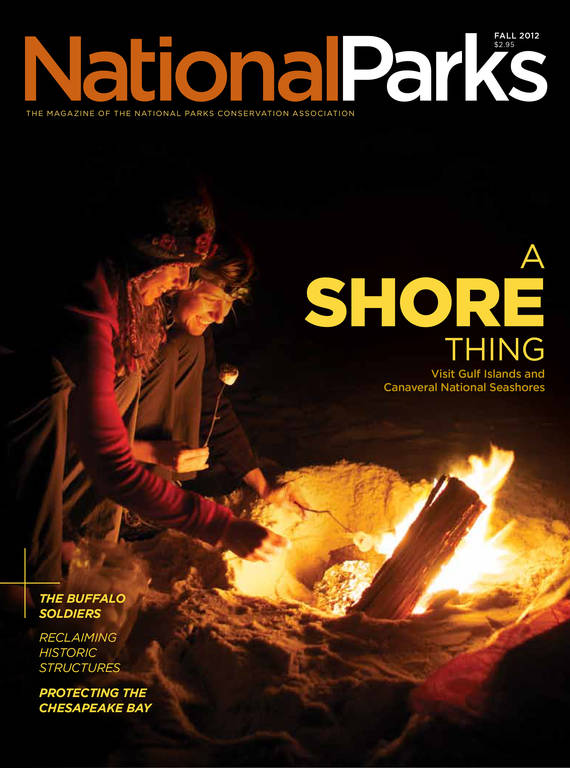Fall 2012
Angel of the Battlefield
Clara Barton’s home, just outside of Washington, D.C., tells the story of the Red Cross founder.
The first thing to catch your eye when you walk through the doorway at the Clara Barton National Historic Site is a wide, V-shaped piece of draped muslin. The stark white cloth—used to hang a ceiling lamp—stands out against the dark side paneling and wooden stairways and blends into the ceiling, also made of the draped cloth. Fittingly, the founder of the American Red Cross and the famed Angel of the Battlefield during the American Civil War had adapted the bandage cloth into building material. “Her diary doesn’t explain why she chose muslin,” says Park Ranger Susan Finta, “but there are entries complaining about the cost, smell, and time it takes to cure plaster. And the next thing you know, she’s nailing muslin all over the place.”
Built in 1891, the house was given to Barton by two brothers with plans to develop a cultural and intellectual residential community in Glen Echo, Maryland, nine miles from downtown Washington, D.C. The Baltzley brothers believed that if the world-renowned humanitarian lived in the community, others would buy property there. As it so happened, Barton was looking for a permanent headquarters for her fledgling organization.
LIFE BEFORE THE RED CROSS
But she soon found that the three-hour commute to Washington—by trolley and horse-drawn bus—proved too much for her hectic schedule, and she moved back to D.C. The building became her warehouse. Barton didn’t make it her permanent home until the trolley line reached the site; she was 75 years old.
Even then her home remained primarily a warehouse. Shelves, closets, and hidden stairway cupboards were there to meet the needs of the Red Cross. “It’s about being prepared before disaster occurs,” says Finta. “People donate items when they want to give, not necessarily when you need them, so Barton needed plenty of storage.” The eight to 10 people staying over at any given time—traveling from New York to Washington meetings, for example, or working on a Red Cross project—lived out of their trunks.
Of the 30 rooms, Barton claimed only one as her own. The bed she died in is still here, as is the plain wooden washstand she brought from her family home in North Oxford, Massachusetts. “She appeared elegant and formal in portraits, but her personal lifestyle was not one of extravagance,” says Finta.
Restored to the era of her occupancy, the house and its contents underscore a key personality trait: frugality and scant separation between Barton’s cause and her personal life. She paid the organization’s telephone bill, the Red Cross paid no rent or mortgage, and workers volunteered—or they might be paid in donated dresses. “The whole household routine here was very complicated,” says Finta. “The Red Cross’ chief field agent might have split his time as a groundskeeper turning the turnip bed, while Barton, the president, scrubbed bathrooms.”
Three main rooms served as Red Cross working and dining space, set up today with roll-top desks, a vintage telephone, and other Victorian-era furnishings based on old photos and records. From this spot, Barton ran the organization for the last seven of her 23 years as president, undertaking disaster-relief operations for the Spanish-American War; the Galveston, Texas, hurricane; and an epidemic of typhoid fever that struck Butler, Pennsylvania, in the early years of the last century.

National Parks
You can read this and other stories about history, nature, culture, art, conservation, travel, science and more in National Parks magazine. Your tax-deductible membership donation of $25 or more entitles…
See more ›“Her pioneering of peacetime disaster and international war-relief efforts is an idea that truly changed the world,” says Finta. “We see her influence today with international aid coming after the earthquakes in Haiti and Japan, and the tsunami. When terrible tragedies strike, the nations of the world pull together. That’s due to Clara Barton.”
But there’s more to Barton than the Red Cross—even if she didn’t realize it herself—and you’ll discover that at this site, too.
Barton spent only the last 15 years of her illustrious life at the Glen Echo site, which the Friends of Clara Barton group gave to the Park Service in 1975. But the ranger-led tour encompasses the story of her entire life, placing it in the context of her times, allowing visitors not only to see how she lived and worked but to learn about her other trailblazing accomplishments.
“She was an individual capable of firm action, strong beliefs, and she had an ability to see a need clearly and fulfill it,” says biographer Elizabeth Brown Pryor. “To everything she did, she brought strong idealism and unfailing energy. She was truly exceptional.”
About the author
-
 Heidi Ridgley Contributor
Heidi Ridgley ContributorHEIDI RIDGLEY writes about history, travel, and wildlife conservation from Washington, D.C.



